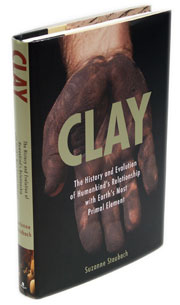  |
| HOME | THIS ISSUE | CALENDAR | GRANTS | BACK ISSUES | < BACK | NEXT > |
Staubach’s new book unearths role of clay in human historyby Karen A. Grava - December 5, 2005 |
||||
|
Suzy Staubach is not only a book seller and avid reader, she’s also an author. The manager of general books at the UConn Co-op recently published a new book, Clay (Penguin Group US). The book’s topic, clay, is something Staubach knows viscerally as both a potter, who has her own kiln at her Ashford home, and a gardener. But her interest in clay also includes the historical. “Clay is crucial to the computer and space industries, to biotechnology, to the publishing industry, for water clarification, and for a wide range of manufacturing processes,” she says in the book. “The potter’s wheel was the very first machine. With the invention of pottery came cooking and storage vessels, ceramics, the discovery of alcoholic beverages, the oven, clay tablets for the first written communication, irrigation for agriculture, vast trade networks, plumbing, sanitation, and its use as an incredibly durable building material.” The book, recently advertised in The New York Review of Books, is organized into chapters on some of the many uses of clay throughout the centuries. Each is designed to comment on, as noted on the cover, “the history and evolution of humankind’s relationship with earth’s most primal element.” One of the most common materials on earth, clay is something Staubach has been thinking about for a long time. “As a bookseller, I have seen every book even remotely connected to clay,” she says. “I have been saving tidbits and facts and notes for years because I thought that I would write about it someday.” When the day came, however, there was a lot of pressure. “I wrote two chapters and an outline, and an agent took the project on,” Staubach says. “Three publishers were interested in it. But when it came time to sign the contract, I was given just over a year to get it done. It was horrifying!” Soon, Staubach was at her desk every morning, working on the book at home before coming to campus for her job. “I got up at 4 a.m. to work on the project,” she says.
As the project moved forward, she stored more and more information on index cards which were stacked neatly throughout her house. Piles of books were sorted for easy fact checking, and soon the project was all-consuming. But the house was “just not big enough for all of the piles on different topics,” Staubach says. So one outgrowth of the project is an addition to her home, which will become a kitchen so that the old kitchen can become a library. To help market her book, Staubach is making clay amulets to give to purchasers. She has been on a book tour throughout New England, including the Harvard Bookstore in Cambridge, and to the Miami book fair and to Milwaukee, Wis. This week, she will be signing books at the Co-op, at the type of event she often organizes for other authors. The signing will take place at 7 p.m. on Wednesday, Dec. 7. Writing is not new for Staubach, who has published a driver’s guide to Connecticut and has been a regular contributor to the College Store Journal, Fine Gardening, Garden Way, Mother Earth News, Old Farmer’s Almanac, and Parents. Many of her articles published in those magazines have been accompanied by photos taken by her companion Joseph Szalay, an attorney who also took photographs for Clay. Now that Clay is written, says Staubach, she plans to return to the kiln where she likes to make simple, functional pottery used as table and garden ware. She is also thinking about her next book, which may be a biography of poet, teacher, and artist M.C. Richards; a book on sunken gardens; or perhaps even another book on clay. “This book was a way of looking at the world through a particular lens,” she says. “In a way, it is a microhistory.” |
| ADVANCE HOME UCONN HOME |

